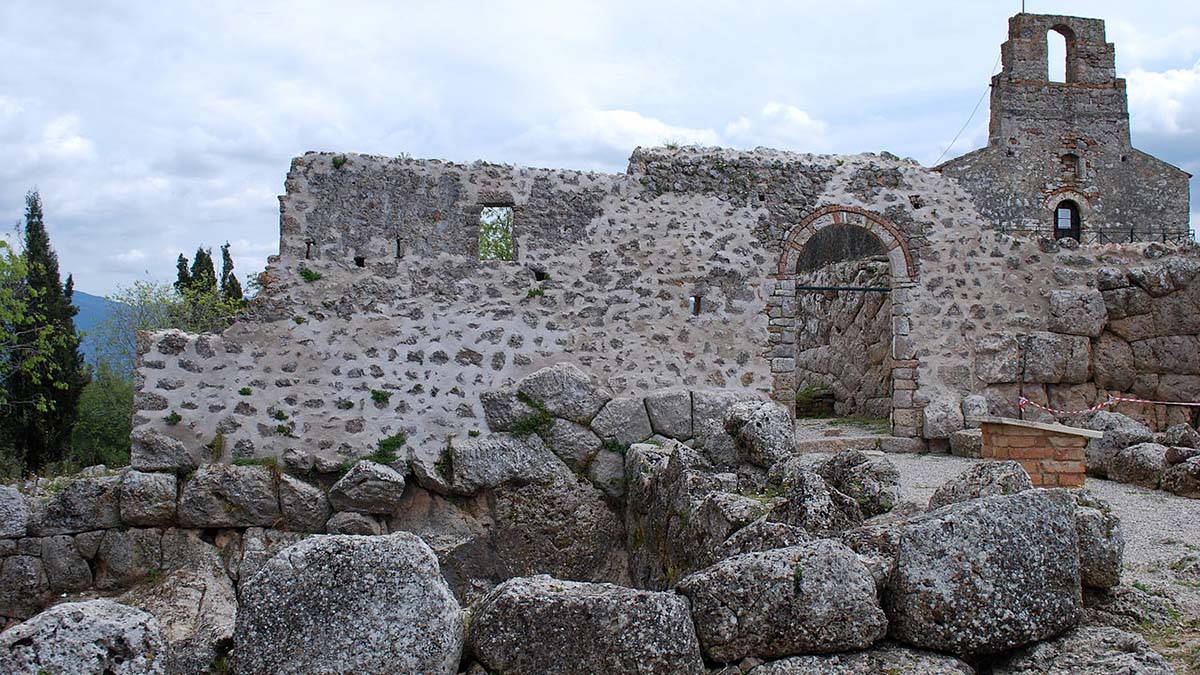
Acheron, Greece: Welcome to the Realm of Hades and Persephone
by W. Ruth Kozak
The boat cuts a silent swathe through the jade coloured water of the narrow river. I imagine crocodiles lurking in the shallows. And surely those tangled boughs that dip into the murky surface shelter coiled serpents ready to strike. I spot several turtles basking in the morning sun on a submerged log.
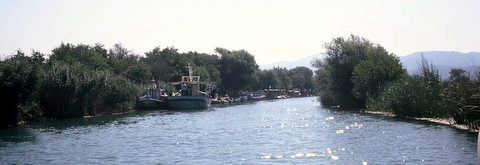
We cruise the narrow waterway under drooping boughs of willows, the muddy banks thick with a hedge of tall sedge. Black and emerald dragonflies dart over the water. But though there may well have been crocodiles here in by-gone times, and undoubtedly there are snakes among the reeds, this is a river in Greece.
I am on a slow-moving motor launch sailing up the mysterious Acheron River, symbolized in Greek myth as the River Styx. There are no corpses aboard this boat, their eyes sealed shut with gold coins. The ferry man is not Charon, but a jovial old salt, Captain Kostas, who has kept the passengers entertained as he navigated the boat up the river from the port of Parga. I am on my way to visit the Oracle of the Dead, the Necromanteion, a mystical sanctuary that the ancient Greeks believed to be the entrance to the Underworld.
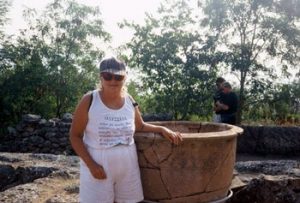 Captain Kostas moors the boat by a reedy embankment from where the passengers must walk two kilometres to the site. I trudge up the gravel road, through the corn fields. On a hillside, protected by cyclopeon walls and an inner circuit of polygonal masonry, dark passageways lead to the mouth of an underground cavern which was believed to be the entrance to the realm of Hades and Persephone. Ancients came here to consult the souls of the dead who, on leaving their bodies, acquired knowledge of the future.
Captain Kostas moors the boat by a reedy embankment from where the passengers must walk two kilometres to the site. I trudge up the gravel road, through the corn fields. On a hillside, protected by cyclopeon walls and an inner circuit of polygonal masonry, dark passageways lead to the mouth of an underground cavern which was believed to be the entrance to the realm of Hades and Persephone. Ancients came here to consult the souls of the dead who, on leaving their bodies, acquired knowledge of the future.
The Necromaneteion near the beautiful town of Parga on Greece’s west coast, belonged to the ancient Bronze Age city of Ephyra, the ruins of which are located nearby. The site had been inhabited since Mycenaean times judging from the finding of several shards and a bronze sword dating to the 13th century BC. The labyrinth and buildings, which include store rooms, priests lodgings, dormitories, baths and a courtyard, were discovered in 1958.
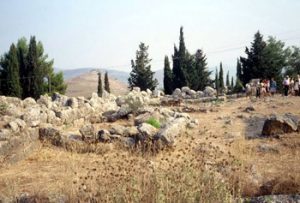 The Necromanteion was the most famous sanctuary of its kind in antiquity. Many pilgrims visited there including Odysseus, who attempted to conjure Achilles’ ghost. The ancients believed that a persons’ soul was immortal after its freedom from the body, and that a mortal’s contact with the dead, with a view to predict the future, demanded special sacrifices and rituals. Offerings of milk, honey and the blood of sacrificed animals were made in the hope of conjuring the spirits of the departed.
The Necromanteion was the most famous sanctuary of its kind in antiquity. Many pilgrims visited there including Odysseus, who attempted to conjure Achilles’ ghost. The ancients believed that a persons’ soul was immortal after its freedom from the body, and that a mortal’s contact with the dead, with a view to predict the future, demanded special sacrifices and rituals. Offerings of milk, honey and the blood of sacrificed animals were made in the hope of conjuring the spirits of the departed.
The pilgrims were subjected to three stages of physical and spiritual tests during which they were isolated in the dark rooms of the Oracle. Obliged to follow a special diet of beans and various hallucinogenic substances, they prepared to meet the souls of the dead. After several days of magical rituals, prayers, invocations, and questioning by the priests, the supplicants were led down the dark smoke-filled corridor of the labyrinth to the entrance to Hades, having faith that the apparitions of the dead would appear to them. An underground vault, thought to be the dark palace of Persephone and Hades, was the meeting place of the dead and the living.
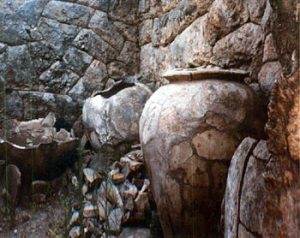 I descend into the cold, musty crypt by a narrow stairway. The chamber is carved in the rock with 15 stone arches supporting the roof. It dates to the end of the 4th century. It is here that the pilgrims were believed to have communed with the dead. As I stand in the gloom of the stone cavern I try to conjure a few ghosts of my own. It is an eerie place, not impossible to imagine how the pilgrims, disoriented and under the influence of potions, could be fooled into believing the Dead were really there communicating with them.
I descend into the cold, musty crypt by a narrow stairway. The chamber is carved in the rock with 15 stone arches supporting the roof. It dates to the end of the 4th century. It is here that the pilgrims were believed to have communed with the dead. As I stand in the gloom of the stone cavern I try to conjure a few ghosts of my own. It is an eerie place, not impossible to imagine how the pilgrims, disoriented and under the influence of potions, could be fooled into believing the Dead were really there communicating with them.
During Roman times, in 167 BC, the Oracle was proven to be a hoax when pulleys were discovered in the chamber, which apparently had been used to hoist up the priests who simulated the departed and answered the questions of the pilgrims. The walk through the hallucinogenic smoke of the labyrinth, the isolation and rituals they had performed during their stay, prepared them for accepting the appearance of the ‘dead’ person as ‘real’. After this discovery, the Necromanteion was destroyed and lay hidden until it was excavated in 1958 and restored by the Archaeological Society of Athens.
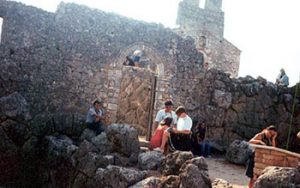 As with many ancient sites, a Greek Orthodox chapel has been built over the old ruin. Inside, the wall is painted with an icon of the Virgin Mary and her son Jesus. In the flicker of candlelight, the image is barely visible but as I look closer, a blackish figure, barely visible in the darkness of the cave-like sanctuary mysteriously appears, just as the apparitions of the dead appeared to the ancients who came there seeking their counsel.
As with many ancient sites, a Greek Orthodox chapel has been built over the old ruin. Inside, the wall is painted with an icon of the Virgin Mary and her son Jesus. In the flicker of candlelight, the image is barely visible but as I look closer, a blackish figure, barely visible in the darkness of the cave-like sanctuary mysteriously appears, just as the apparitions of the dead appeared to the ancients who came there seeking their counsel.
After visiting Hades, I board the launch again to return to Parga, cruising downriver to the Acheron delta, then out to the open sea. A brisk wind has blown up and Captain Kostas navigates the boat through the choppy water sailing precariously close to the rocky shoreline. Great jagged rocks loom out of the sea like giant sea monster’s teeth. The limestone cliffs are riddled with caves where pirate ships used to hide.
We sail past secluded coves with dazzling turquoise water, stopping to anchor at one of the pristine white-sand beaches, to spend the afternoon luxuriating in Paradise until it is time to board again and head back to Parga. The trip to Hades is a chance to experience a séance ancient style. An excellent day’s outing all for 7.50 Euros.
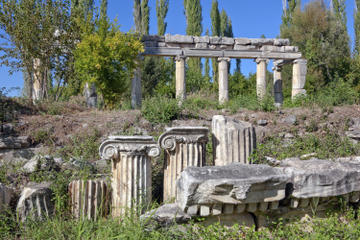
Private Tour: Ancient Agora of Athens Walking Tour
If You Go:
The Necromanteion is open from November – March Daily 8.00am – 3.00 pm; July to October, Daily 8.00am to 9.00 pm
Admission (not included in cruise) 2 Euros; 1 Euro for seniors and children
Tickets can be purchased at the port in Parga for the cruise up the Acheron (7.50 Euros).
The site can also be reached by car on the Preveza road to Messopotamo.
Guided tours by bus also operate from Parga.
WHERE TO STAY (In Parga)
During July/August accommodation is tight but domatios can be found on the hill near the Kastro, ranging from 35 – 50 Euros. Domatio owners will usually meet the buses and offer their lodgings. I found an exceptional self-contained suite in this way for just 35 Euros a day. There are also three camp sites nearby.
HOW TO GET THERE
There are buses from Athens (a seven hour journey, three times a day) 24.50 Euros
The bus depot in Parga is located up the hill from the port.
Parga is 53 km. north of Preveza
About the author:
W. Ruth Kozak loves mysterious places and this trip to the depths of Hades was a highlight of her travel adventures. Besides being one of the most ancient sites of Greece, it is one of the most unusual, certainly haunted by the ghosts of by-gone days including the fabled hero of the Troy Wars, Achilles. You can read more of Ruth’s travel adventures on her blog: www.travelthroughhistory.blogspot.com
Photo credits:
First Necromanteion photo by Jean Housen / CC BY-SA
All other photos are by W. Ruth Kozak


